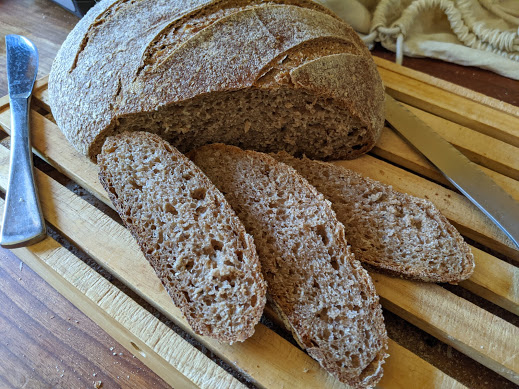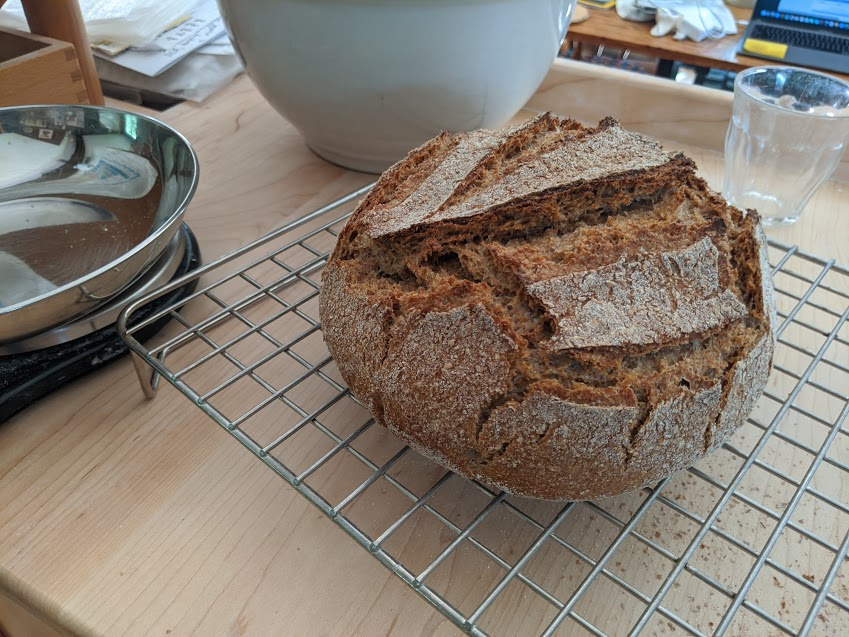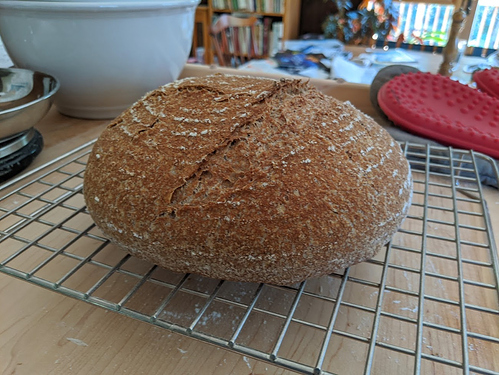Cool. Here’s a review of Flour Lab: https://www.saltwire.com/lifestyles/food-and-drink/in-flour-lab-adam-leonti-illustrates-why-fresh-flour-cant-be-beat-455437/. I will order a copy forthwith. Thanks for the reference. Other than Amazon and Target, reviews are from Canadian media for some reason. Maybe it’s because of praise for grain from Manitoba. The author thinks freshly ground coffee is more flavorful than store or industrially ground coffee. Wait till he has it freshly roasted as well as freshly ground!
Here is a 930g boule of 100% Turkey Red whole wheat from the dough I mentioned yesterday, the Lutz Geißler bread. It’s still cooling so I haven’t cut into it. The bread is springy, though, so probably has an open crumb. The way the crust broke suggests that the gluten wasn’t perfectly developed, but the springiness and the lovely odor make me look forward to dining on it. It was so warm indoors yesterday that the last 15 hours of fermentation took place on the bottom shelf of the refrigerator instead of out on the counter. Maybe if I’d let it proof for more than 70 minutes after shaping there would have been less oven spring and a more handsome appearance. Persevering with Turkey Red wheat berries!
Wow that is beautiful! Congratulations!
That looks like a success to me! Very impressive. Now that I’ve got my 100% turkey ww sandwich bread working, I’ll have a go at 100% turkey ww sourdough.
By the way, I looked up the book you mentioned and could only find German language copies. Sprechen Sie Deutsch? 
Thanks. I took two years of German in college and passed a pretty easy test in it in grad school. I have fiddled with it a bit over the years since. A couple three years ago I began accumulating German and Austrian bread books in order to learn more about German bread. German speaking countries have a fine bread tradition, one they think is richer than the French tradition that gets so much attention. Between a German-English dictionary, Google Translate, and the fact that the books are all about bread, a familiar topic, I am able to suss out formulas and methods for the most part. Like a lot of things, if you keep at it you get better.
Here is another go at Lutz Geißler’s whole wheat loaf. As before, the dough ripened more rapidly than the instructions suggested. This time I shaped the boule after 11 1/2 hours at room temperature instead of 24, then proofed it overnight on the top shelf of the refrigerator. Except for one gram less salt, I followed the instructions closely up to the point of cutting short the bulk fermentation and using the refrigerator. This time there appears to have been normal gluten development. I strove to handle the dough seldom and gently. Turkey Red wheat here behaved more like the Connecticut River Valley Warthog I am used to.


That’s a beautiful loaf of bread; nice work.
Sorry if I’m a broken record in here, but two things to consider more as a vague suggested starting point than a hard and fast instruction in any sourdough bread recipe:
- amount of water
- proofing time
In my experience, both of those things must be adjusted to fit your own circumstance (temperature, flour, starter, other invisible variables).
Also in my experience Turkey Red wheat doesn’t seem any more or less finicky than any other hard red wheat variety.
You are correct about hydration and fermentation time. I thought I’d specified those things in an earlier post, but I hadn’t. So, this was a “lazy bread,” 1.8% (baker’s percentage) sourdough seed mixed with 72% water, 2% salt, and the flour. Once mixed, the dough was stretched and folded at about 6 hours and coil folded at 11 hours. Soon after the 11 hour point it was shaped and refrigerated for 9 hours before baking. It may well be that the earlier trouble I had with gluten development was due to other factors and not the wheat variety.
Interestingly, I am beginning to reach the same conclusion: that Turkey red wheat performs fine in bread baking and my issues were caused by other factors. Fermentation was so accelerated that the gluten developed and broke down in less time than it normally takes to get through the bulk phase. I misread it as weak gluten (because I only saw this happen when there were no other flours in the mix) and was off-base in that assessment. @homebreadbaker, you spoke to “proofing time” in your initial message and your observation was exactly on point. Thank you.
@tstavely, the bread posted above shows an amazing rise. Great work. You’ve posted some beauties! Today, I’m working on a new (to me) formula from Heritage Baking by Ellen King. It is composed of high extraction and whole wheat flours, all fresh milled. I handled the dough with kid gloves, but it is now looking pretty puffy in the fridge and I fear it won’t make it till morning. Sure hope I don’t end up having to do a midnight bake…
Here is further confirmation that as @homebreadbaker says, Turkey Red wheat behaves like most others in bread. My difficulty with the grain seems to result from not doing satisfactory gluten development. Addressing that problem, here is today’s 900+ g. loaf of whole grain Turkey Red sourdough mixed using the Rubaud method or an approximation (dough hydration = 75%, 14.5% fermented flour from a 75% hydration leaven, salt around 1.5%).
I have seen a lot of information about pros and cons for autolyse with fresh milled grains. Some folks say it is not to be done because of the rapid enzyme activity of the grains and other reaons. Others say autolyse is necessary to soften the bran and make the dough easier to work with. Some say adding salt to the autolyse will control the enzyme issue while allowing for the flour to hydrolyze. I am trying to decide what I should do. I do not use any store bought flour and exclusively mill all my grains and typically use a 95 - 99 % extraction. Is there a general consensus for autolyse with fresh milled grains?
Eric
I use home-milled 100% whole grain wheat for my usual bread and I do what is technically called a “fermentolyse” because I have the starter in (as well as the salt). Basically I mix everything all together and then run the stand mixer for just a couple minutes until it gets to a shaggy mass stage and then I turn off the mixer, cover the bowl with plastic, and let it sit for an hour or so.
I say this is technically a “fermentolyse” because I do have the starter in there. However, in practice if you know how I bake (see slow, lazy, sourdough), you’ll know that I use such a minuscule amount of starter that in all practical likelihood, what I am doing is really closer to an autolyse or “saltolyse” than what most people mean by “fermentolyse” because during that hour the amount of microbial activity in my dough is tiny.
The difference in workability and performance of the dough between doing that 1 hour rest vs. not doing it and instead kneading / mixing it fully right after putting everything together is far bigger than makes sense to me intuitively. It makes a huge positive difference in dough feel, strength, crumb openness, and oven spring.
In my estimation, the answer to this is dependent upon the grain and the formula. Some flours are stronger, some are weaker; some are more enzymatic and some are less so; some are highly absorbent, some are not. I’m not a professional miller (not even a particularly knowledgeable home miller), but here is how I understand this. Others, please feel free to correct me.
Commercial flours are tested for many properties at the mill and blended with other flours and sometimes additives, to arrive at a final product that meets their specifications. They also age their flour for improved elasticity, structure, and other desirable attributes. With all of these measures, the buyer gets a pretty consistent and predictable product from bag to bag, year over year. Most of us who mill at home aren’t able to conduct such tests so we have to manage our dough instead. Every time I try a new grain, a new supplier, or even the same grain from the same supplier but grown in a different crop year, I know that I have to pay particular attention to how the dough develops and be prepared to respond accordingly. Usually, that means withholding some water at the outset and doing a short autolyse. It’s easy to increase hydration if the flour requires it. If my short autolyse is still too long, I know to shorten it even more, add some salt, or eliminate it the next time. If your dough seems to be moving quickly after autolyse, it might be fair to expect a short bulk phase. Depending on the flour and the baker’s goals, some might find it helpful to add a tiny pinch of malt or Ascorbic acid. There are many adjustments that can be made. Taking careful notes can help nail down a process more quickly. I hope this helps.
This would come up every now and then on a website for commercial bakers. I finally decided Ascorbic acid (vitamin C) is not something I, as a home baker, needs to be concerned with only because I can’t get the ratio right. Commercially, it is something like 1/4-teaspoon (2g) ascorbic acid mixed with 100k (220-lbs) of flour. Try scaling that down to a loaf of two. ![]() As home bakers the closest we can get is to wave a 500mg vitamin C capsule over our 5-lb bag of flour and hope the gesture is accepted by the baking gods. There is a lot of disinformation on various bread forum regarding AA. I go with what Dr Lin Carson (PhD in food science), aka Queen of All Things Baked, has written about ascorbic acid in bread flour on the bakerpedia.com website. She has also explained about it in various videos.
As home bakers the closest we can get is to wave a 500mg vitamin C capsule over our 5-lb bag of flour and hope the gesture is accepted by the baking gods. There is a lot of disinformation on various bread forum regarding AA. I go with what Dr Lin Carson (PhD in food science), aka Queen of All Things Baked, has written about ascorbic acid in bread flour on the bakerpedia.com website. She has also explained about it in various videos.
The first 4 minutes of this video probably has more info about ascorbic acid (AA) in bread dough then anyone ever really wanted to know:
https://www.face book.com/BAKERpedia/videos/monday-mornings-with-dr-lin-ascorbic-acids-function-in-frozen-dough/909047803081425/
ETA: the link only show if I put a space between ‘FACE’ and ‘BOOK’. You need to copy that address, paste it in your browser and remove the space.
Hi Otis. I agree with you and, actually, I almost deleted that part. Thanks for the opportunity to clarify. I personally don’t add Ascorbic acid to my breads (although I do know someone who swears by lemon juice, which is just a way of getting dilute AA in there). I have added malt powder to commercial flours in certain circumstances. TBH, I can’t imagine adding malt powder to green flour; if anything, it would have been counter-productive for every flour I’ve milled over the years. Might it be useful if the flour was bolted and aged? Maybe, I don’t know. It was really just my intention to let the baker know there are always options and that those options vary with the circumstances.
I’m not on Facebook so I can’t view the video just yet, but I’ll check it out next time I visit the 21st Century over at my daughter’s house ![]() . Thanks!
. Thanks!
You can watch that video on facebook without an acct. I don’t have facebook, I can’t see anything on facebook, except some Bakerpedia vids. I don’t know why it works but you should be able to watch it.
Put this into a search engine: facebook video dr lin carson ascorbic acid
I used duckduckgo and the first search result is the video I reference: Monday Mornings with Dr Lin, Ep 20.
She mentions in the video ascorbic acid benefits fermentation times 2-hrs or less, so I guess adding AA is lost on sourdough fermentation times. I also read something on bakerpedia website that mentions adding fruit to bread dough introduces ascorbic acid to the dough. What I read made no mention of the need for the fruit to be citrus. Indeed, many fruits have vit C and it only takes such a little bit of it to have an affect on the dough. Too much AA makes the crumb go soft.
You are right, I was able to access it. Interesting content. I’ll check out more from this provider. Thanks


